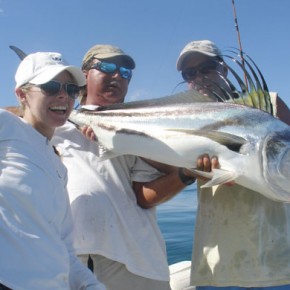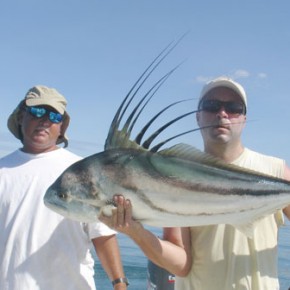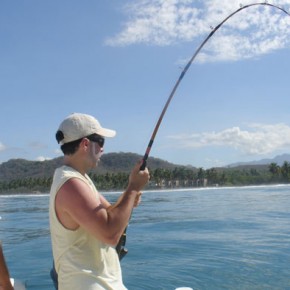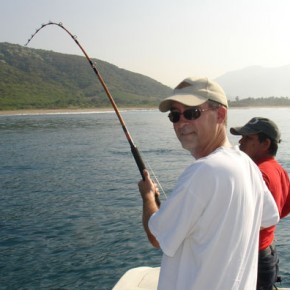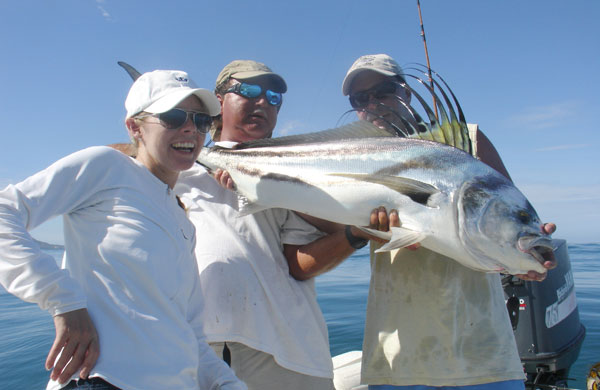
Rosario Tortorice, Mike and Adolfo with a nice rooster on the panga Dos Hermanos. Photo by Ed Kunze.
If you had to make a choice for a single line weight to use in salt water fishing, what weight line comes to mind first?
Remember, it doesn’t matter if it is braid line or mono-filament.
The dedicated light line sportsman would probably choose twenty pound test, and have many a valid argument. Using a 100 pound leader, a twenty pound outfit can easily handle a Pacific sailfish of eighty pounds, plus bonefish on the flats, roosterfish, giant trevely, and many tuna species to sixty or eighty pounds. And, they have the option of using either conventional gear or spin gear, as twenty pound works great on both.
In fact, I was amazed once when we were on a San Diego sport fishing boat and chasing albacore. We were picking up a couple of the twenty-five to thirty pound fish on several jig stops throughout the day, but no wide open action. One fisherman had only a single twenty pound outfit with him, as compared to the four to eight rods by the other anglers. And unlike the others, with a tackle shop worth of tackle in their huge boxes, he had a small tackle box smaller than the span of his one hand. That was all he needed, as he only had different sized hooks to match the size of the live bait, and a few rubber core sinkers sized to match the depth of the school. He ended up with eight albacore that day, with the rest and their thirty to eighty pound outfits averaged about four.
You could deem the sixty or eighty pound test as being the best single line choice, and have significant merit in thinking so. More big game, like sailfish, large tuna, and marlin are taken on these two line tests than any other. In fact most captains in Mexico are running sixty pound line on the outfits they are trolling with, with an eighty pound outfit also rigged for a big blue marlin. And when trying to winch out a huge snapper or grouper from its lair, these larger lines have more abrasion resistance than a lighter line.
I would propose that a forty pound test line should be your first choice as the all around versatile line, with a respectful nod to the others. But, please remember there are no standard line diameters in the tackle industry to compare to the test of the line. There can be a lot of variation. A similar comparison could be made with a bullet for a rifle. Without the stringent controls of bullet manufacturing in place, an advertised 150 grain bullet could then be anywhere from 140 grains, to 160 grains.
Let’s talk about the math a bit…
One line manufacturer lists their twenty pound line diameter at .046 mm, the forty pound at .61 mm and the eighty pound at .89 mm. If you multiplied the twenty pound diameter of .046 mm x 2 = .092, the result is not the forty pound line diameter; rather it is a little more than the diameter of the eighty pound line. How can it be you multiply by two, and get the results of the line diameter which is four times the breaking strength of the twenty pound line? Remember the equation to determine surface area of a circle; 3.14 times the radius squared? The surface area of the eighty pound line, with a diameter of .89 mm has almost four times the surface area of the twenty pound line diameter, meaning four times more strength.
Once the math is understood, it is easy to see why a line class in the middle of the twenty and eighty pound lines would be favorable. It will have a fairly high strength, yet a small enough diameter to be very effective. And, have you ever tried breaking forty pound test line? You might as well be trying to break eighty pound test, because it almost can’t be done.
Back to that San Diego sport boat…
It was the Cortez, owned and captained by Dean Adams. I caught eight albacore that day, using forty pound, but I knew how to cast light bait with forty pound test. I learned to cast for distance using forty pound line on a conventional reel using a wooden clothes pin clipped on the end of the line. The others were not proficient enough to cast to the spot where the chum was landing and found it was much easier to cast the twenty pound line. Basically, experience helps.
When the season was mostly over, and the other boats were heading for their annual maintenance in dry dock, Dean had a commercial license and invited a few of us to go along for the most incredible albacore fishing I have ever experienced, with him keeping the fish. We only fished with forty pound line. He would actually take pliers and lock the star drags down. The idea was to get the tuna’s head turned to the boat, basically winch him in, and the gaff had better be right there and accurate, or you had one mad tuna on your hands.
There is no IGFA classification for forty pound line. The next size up is fifty pounds, but it is so hard to break forty pound, it should be of little concern. The thinner diameter of the forty pound line may even mean you get a hook up from a once in a lifetime fish, that may not have happened with fifty pound.
For major big game, like 300+ pound blue marlin, forty pound line is not recommended. Not because it won’t do the job, as our modern drag systems and line capacity on the reels will get it done, but there would be just too much stress on the fish for the release. It will take too long to get them in.
However, from amberjack to yellowtail, and every letter in the alphabet in between, the forty pound outfit will be the most versatile and overall performing saltwater line.
-November 2010
- Rosario Tortorice, Mike and Adolfo with a nice rooster on the panga Dos Hermanos. Photo by Ed Kunze.
- Mike, Adolfo and the rooster. Photo by Ed Kunze.
- Mike and Adolfo, putting on a lot of pressure on a rooster with a 40 pound line outfit. Photo by Ed Kunze.
- Russ Weaver. Photo by Ed Kunze.

